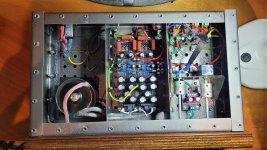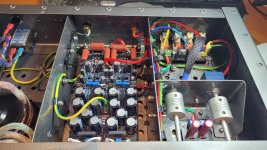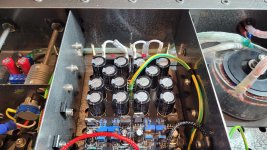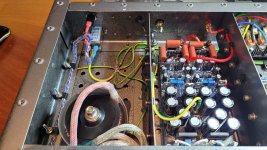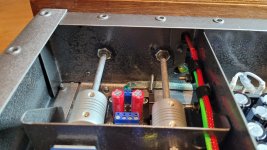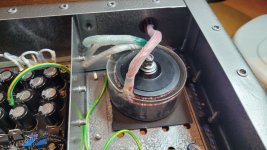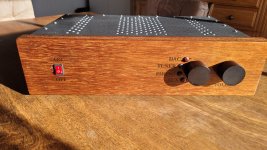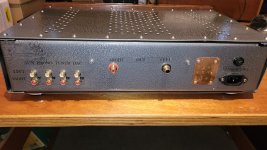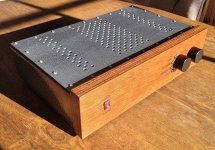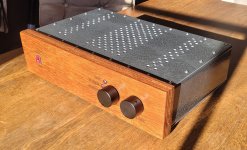G'day Guys,
I am working on a PCB design to fit in place of a Broskie 12VAC Aikido PCB.
Long story short, I have run out of tubes for the 12VAC Aikido so it is time to pass that sought after board onto somebody else.
It's also a good excuse to use a FE2022 essentials kit I impulse bought from the store a while back.
The catch is that I spent 6 months making a chassis around the Aikido. I spent too much time cutting, folding, drilling, sanding and painting not to reuse the chassis.
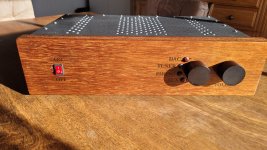
The new pcb has to go here:

The goal is to get everything onto one board so that I can simply replace the donut and PCB and button everything back up for immediate use.
Hopefully no drilling into my lovely paint work. Definitely no cutting!
That means a PCB of the same dimensions as the 12VAC Aikido or at least the same hole centers.
I am working off of the V0R1 schematic:
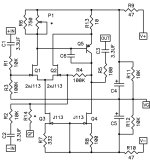
I have removed R14 as it isn't needed.
I have removed the trimpot P1 as I am not worried about DC offset.
I have removed R11/R12 as I am using a bipolar supply.
I have removed R9/R10 as I think these are an RC filter for an external DC brick and I will be using a regulated linear supply.
I have kept C6, just in case.
I have decreased C4/C5 to 100uF which seems sensible to me as decoupling for a regulated PSU.
Thus I have come up with this:
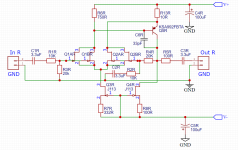
The PSU will be a VRDN. I was going to shoot for +/-24Vdc rails but I don't have any appropriate donuts, so I will run +/-20Vdc rails.
I have applied the changes Mark Johnson recommends for immunity to manufacturer variations in the LM317/337.
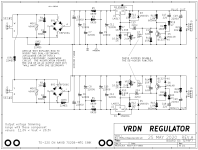
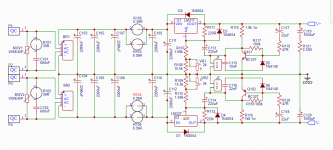
And here is the first draft of one channel of the FE2022 part of the circuit.

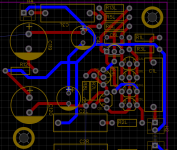
Shown with the output caps of the VRDN on the left.
I am happy with the parts placement.
The grounding is subject to change as I layout the PSU but I intend to keep the signal ground separate from the PSU ground except for the single point of connection.
I am going to see if I can fit separate regulators for each channel driven from the combined cap bank.
a) LM317/337 and denoiser parts are cheap.
b) This should allow me to get the regulator outputs closer to the FE2022.
I am wondering if with the output of the regulator so close to the FE2022, whether decoupling is necessary at all?
I am working on a PCB design to fit in place of a Broskie 12VAC Aikido PCB.
Long story short, I have run out of tubes for the 12VAC Aikido so it is time to pass that sought after board onto somebody else.
It's also a good excuse to use a FE2022 essentials kit I impulse bought from the store a while back.
The catch is that I spent 6 months making a chassis around the Aikido. I spent too much time cutting, folding, drilling, sanding and painting not to reuse the chassis.

The new pcb has to go here:

The goal is to get everything onto one board so that I can simply replace the donut and PCB and button everything back up for immediate use.
Hopefully no drilling into my lovely paint work. Definitely no cutting!
That means a PCB of the same dimensions as the 12VAC Aikido or at least the same hole centers.
I am working off of the V0R1 schematic:

I have removed R14 as it isn't needed.
I have removed the trimpot P1 as I am not worried about DC offset.
I have removed R11/R12 as I am using a bipolar supply.
I have removed R9/R10 as I think these are an RC filter for an external DC brick and I will be using a regulated linear supply.
I have kept C6, just in case.
I have decreased C4/C5 to 100uF which seems sensible to me as decoupling for a regulated PSU.
Thus I have come up with this:

The PSU will be a VRDN. I was going to shoot for +/-24Vdc rails but I don't have any appropriate donuts, so I will run +/-20Vdc rails.
I have applied the changes Mark Johnson recommends for immunity to manufacturer variations in the LM317/337.


And here is the first draft of one channel of the FE2022 part of the circuit.


Shown with the output caps of the VRDN on the left.
I am happy with the parts placement.
The grounding is subject to change as I layout the PSU but I intend to keep the signal ground separate from the PSU ground except for the single point of connection.
I am going to see if I can fit separate regulators for each channel driven from the combined cap bank.
a) LM317/337 and denoiser parts are cheap.
b) This should allow me to get the regulator outputs closer to the FE2022.
I am wondering if with the output of the regulator so close to the FE2022, whether decoupling is necessary at all?
I have managed to get the layout to do what I want it to do:
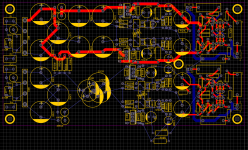
Left channel "complete", Right still pending of course. But I now know it will all fit as I intended.
I managed to fit a pseudo dual mono where by each channel gets its only cap bank and regulator after the first 'C' stage of the CRC filter.
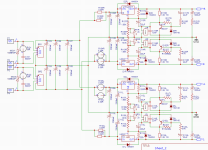
Prettying up the routing, running the grounds and general prettying of the silkscreen etc to follow.

Left channel "complete", Right still pending of course. But I now know it will all fit as I intended.
I managed to fit a pseudo dual mono where by each channel gets its only cap bank and regulator after the first 'C' stage of the CRC filter.

Prettying up the routing, running the grounds and general prettying of the silkscreen etc to follow.
Alright.
Layout done:
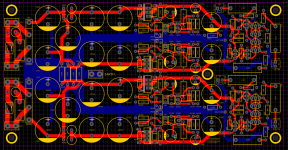
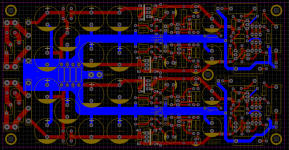
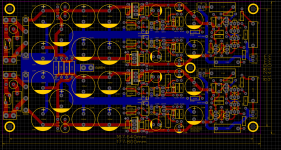
A few checks here and there. Check footprints and lead spacing on the caps for example and I should be ready to send this to the fab.
Minor changes include:
-I have used different bridge rectifiers from the standard VRDN to use what I have on hand from salvage.
-I have applied the modifications to the original VRDN to allow the stable use of non OnSemi regulators as I have ST ones on hand.
-I added C6 back into the FE2022 just in case.
-I went with a 1W resistor for R15/R16 as this was an easier footprint to find compared to 600mW.
Last night I ordered a custom donut from Ali express: 2x20V + 1x18V. The 18vac to drive the input selector relays.
I considered just putting an extra secondary winding on the existing 2x18vac transformer that was powering the 12VAC Aikido. But I want he slightly higher voltage for the VRDN and this way is less messy. The custom ali express donut was the same price as ordering one with 2x20v from Element 14 and then I would have to modify it.
All going to plan I should have this sent off to the Fab and a parts order for what I don't have on hand in the next couple of days.
Layout done:



A few checks here and there. Check footprints and lead spacing on the caps for example and I should be ready to send this to the fab.
Minor changes include:
-I have used different bridge rectifiers from the standard VRDN to use what I have on hand from salvage.
-I have applied the modifications to the original VRDN to allow the stable use of non OnSemi regulators as I have ST ones on hand.
-I added C6 back into the FE2022 just in case.
-I went with a 1W resistor for R15/R16 as this was an easier footprint to find compared to 600mW.
Last night I ordered a custom donut from Ali express: 2x20V + 1x18V. The 18vac to drive the input selector relays.
I considered just putting an extra secondary winding on the existing 2x18vac transformer that was powering the 12VAC Aikido. But I want he slightly higher voltage for the VRDN and this way is less messy. The custom ali express donut was the same price as ordering one with 2x20v from Element 14 and then I would have to modify it.
All going to plan I should have this sent off to the Fab and a parts order for what I don't have on hand in the next couple of days.
Pcbs have been ordered.
Mouser is sending me a bunch of fresh parts. Unfortunately I forgot to order 1000uF caps for C19/C20
I might have something of the right diameter and pitch in my stash somewhere. So far the best I have found is 470uF 35v. These might have to do if I can't find any 1000uF 12mm diameter caps anywhere. I don't think the value on these parts is critical anyway.
Mouser was out of stock of the On semi LM317/337 so I will just use the ST parts I have on hand. Good thing I applied the modifications for non-On Semi parts.
BC327-40/BC337-40 were out of stock also. So I will use some ZTX851/951 I have on hand. I will just need to remember to check the pinout when it comes to stuffing time. IIRC the pinout is reversed for the ZTX parts.
For the DIYFE2022 end. I have most of the resistors on hand in RN55/CMF55 form so I decided to order the extra couple of values so everything matches all pretty. I did price up doing the same for the VRDN end but the cost was just a bit silly. Some values were 6x the price of standard metal film and it just seemed a bit silly for a PSU.
All going to plan I can start stuffing parts in a couple of weeks.
Mouser is sending me a bunch of fresh parts. Unfortunately I forgot to order 1000uF caps for C19/C20
I might have something of the right diameter and pitch in my stash somewhere. So far the best I have found is 470uF 35v. These might have to do if I can't find any 1000uF 12mm diameter caps anywhere. I don't think the value on these parts is critical anyway.
Mouser was out of stock of the On semi LM317/337 so I will just use the ST parts I have on hand. Good thing I applied the modifications for non-On Semi parts.
BC327-40/BC337-40 were out of stock also. So I will use some ZTX851/951 I have on hand. I will just need to remember to check the pinout when it comes to stuffing time. IIRC the pinout is reversed for the ZTX parts.
For the DIYFE2022 end. I have most of the resistors on hand in RN55/CMF55 form so I decided to order the extra couple of values so everything matches all pretty. I did price up doing the same for the VRDN end but the cost was just a bit silly. Some values were 6x the price of standard metal film and it just seemed a bit silly for a PSU.
All going to plan I can start stuffing parts in a couple of weeks.
PCBs arrived today.

I will test fit some key components too make sure everything fits properly and then start soldering.
We're off to see the wizard!
I will test fit some key components too make sure everything fits properly and then start soldering.
We're off to see the wizard!
Work continues.
This build is playing 2nd fiddle to my mono blocks but I can only do so much at a time on that one so this one is coming along well.
Most of the resistors are soldered on. Soon it will be time for the caps and semis in the power supply so that I can test the VRDN part and make sure it doesn't blow up.
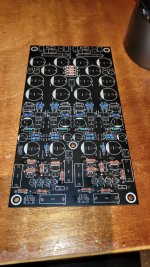
I also decided that since I have some spare epoxy, I may as well pot my freshly arrived custom Ali Express donut.
This time no stupid things like wires coming out the side and making things complicated.
Just an empty vitamin C jar and wires straight out of the top:
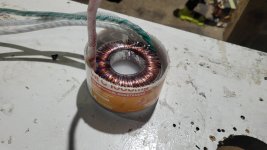
I should have this up for initial testing in the next week or so.
This build is playing 2nd fiddle to my mono blocks but I can only do so much at a time on that one so this one is coming along well.
Most of the resistors are soldered on. Soon it will be time for the caps and semis in the power supply so that I can test the VRDN part and make sure it doesn't blow up.

I also decided that since I have some spare epoxy, I may as well pot my freshly arrived custom Ali Express donut.
This time no stupid things like wires coming out the side and making things complicated.
Just an empty vitamin C jar and wires straight out of the top:

I should have this up for initial testing in the next week or so.
While waiting for epoxy to dry on my Mooly monos I've had an evening soldering on this project.
I de-moulded the donut. This one came out pretty nice.
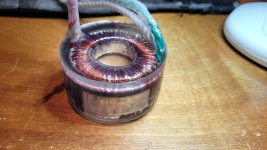
I will need to drill a hole in the centre for the mounting bolt and I might tidy up the meniscus (I don't think i've seen that word since high school science).
If I figure out how to polish epoxy I might just make it all shiny too.
I've completed the FE2022/VRDN board as far as needed for testing the VRDN.
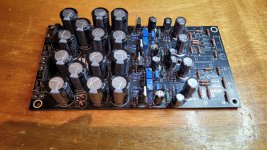
I should be able to start testing in the next couple of days and see if I didn't just made an oscillator.
I de-moulded the donut. This one came out pretty nice.

I will need to drill a hole in the centre for the mounting bolt and I might tidy up the meniscus (I don't think i've seen that word since high school science).
If I figure out how to polish epoxy I might just make it all shiny too.
I've completed the FE2022/VRDN board as far as needed for testing the VRDN.

I should be able to start testing in the next couple of days and see if I didn't just made an oscillator.
I had a brief window of time to play tonight.
No light at all from the dim bulb tester.
No magic smoke.
Good signs to begin with.
Power supply rails are nice and stable.
After the initial overshoot from the denoiser they settled and didn't move according to my DMM.
Right now the values were all over there place from 15-16vdc but no attempt has been made at adjustment as I ran out of time.
Tomorrow night goes to SWMBO so Saturday night I will try adjusting the rails to +/-20Vdc and poke them with the scope to check for any signs of oscillation.
If it passes these tests then I will solder on the jfets and film caps and then into the chassis it goes.
As an aside. There was one small booboo on the layout. The footprint for the trimmers was backwards. I think this just means adjustment will be backwards but I will soon find out.
No light at all from the dim bulb tester.
No magic smoke.
Good signs to begin with.
Power supply rails are nice and stable.
After the initial overshoot from the denoiser they settled and didn't move according to my DMM.
Right now the values were all over there place from 15-16vdc but no attempt has been made at adjustment as I ran out of time.
Tomorrow night goes to SWMBO so Saturday night I will try adjusting the rails to +/-20Vdc and poke them with the scope to check for any signs of oscillation.
If it passes these tests then I will solder on the jfets and film caps and then into the chassis it goes.
As an aside. There was one small booboo on the layout. The footprint for the trimmers was backwards. I think this just means adjustment will be backwards but I will soon find out.
I was allowed a brief play after dinner. Adjustment worked perfectly.
Rails are adjusted to +/- 20.00Vdc
As accurately as my ancient fluke 83 can do.
I measured 1.2mVac across each of the rails with the same old fluke.
I would have hoped for lower noise than that but it is just a DMM.
Next up I will hook up my scope and see what things look like. My scope is about as cheap as they get so it will be interesting to see what i see.
Measurements to come.
Rails are adjusted to +/- 20.00Vdc
As accurately as my ancient fluke 83 can do.
I measured 1.2mVac across each of the rails with the same old fluke.
I would have hoped for lower noise than that but it is just a DMM.
Next up I will hook up my scope and see what things look like. My scope is about as cheap as they get so it will be interesting to see what i see.
Measurements to come.
A few more minutes to play while wifey is putting the little one down.
The noise is below the level I can measure on my scope.
With my scope AC coupled, I get 28mVpp. However I get 28mVpp with the probe not connected to anything.
I will call this a success and continue with assembly.
The noise is below the level I can measure on my scope.
With my scope AC coupled, I get 28mVpp. However I get 28mVpp with the probe not connected to anything.
I will call this a success and continue with assembly.
Well.
I seem to have a bit of oscillation going on.
I'm not sure whether the output is oscillating and going back through the feedback loop or the input is oscillating and affecting the output.
Q1/Q2 source:
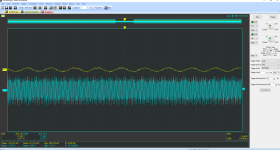
Q2 gate:
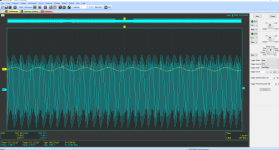
Q3 Drain:
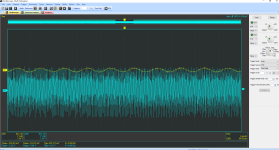
Q4 Drain:
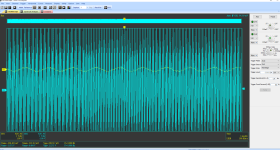
Q5 Collector:
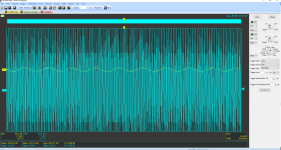
Everything else is clean with a scope.
All measurements were taking with no signal at the input. Just idle. The yellow trace was not actually connected.
I will take an evening to consider what is going on here.
I am leaning towards putting in c6.
I don't have the recommended 33pF Papa recommended in the V0R1 notes so I will start with upper value of 100pF as I have some on hand.
I seem to have a bit of oscillation going on.
I'm not sure whether the output is oscillating and going back through the feedback loop or the input is oscillating and affecting the output.
Q1/Q2 source:

Q2 gate:

Q3 Drain:

Q4 Drain:

Q5 Collector:

Everything else is clean with a scope.
All measurements were taking with no signal at the input. Just idle. The yellow trace was not actually connected.
I will take an evening to consider what is going on here.
I am leaning towards putting in c6.
I don't have the recommended 33pF Papa recommended in the V0R1 notes so I will start with upper value of 100pF as I have some on hand.
This evening I tacked in a 100pF silver mica capacitor I had lying around.
Problem solved. A nice clean output.
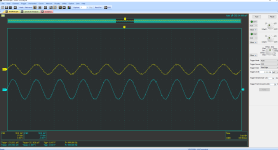
Into a 10k load.
So clearly it was Q5 oscillating and then feeding back to the input.
My next step will be to work my way down in value of c6 to get it as low as possible while ensuring stability.
I've got some 22pF wima's somewhere that I think I will try next.
Problem solved. A nice clean output.

Into a 10k load.
So clearly it was Q5 oscillating and then feeding back to the input.
My next step will be to work my way down in value of c6 to get it as low as possible while ensuring stability.
I've got some 22pF wima's somewhere that I think I will try next.
Last edited:
22pF is sufficient to curb the oscillation. I don't have any Wimas on hand in such a value. Just TDK NP0 ceramic caps.
The next value down I have is a 10pF in a X7R ceramic. I am wondering if it is worth going any lower or I replace the 100pF in the other channel with the 22pF and be done with it.
The next value down I have is a 10pF in a X7R ceramic. I am wondering if it is worth going any lower or I replace the 100pF in the other channel with the 22pF and be done with it.
The LM337 is a finicky regulator and is known to cause problems. It is especially finicky about its output capacitor. A high ESR capacitor is better than a low ESR capacitor.
I also see that the output of the negative rail is missing a resistor in series with the capacitor.
Have you checked the output of the power supply for oscillations?
I also see that the output of the negative rail is missing a resistor in series with the capacitor.
Have you checked the output of the power supply for oscillations?
Morning Ben,
No sign of oscillation in the psu. Although now that I think about it. I didn't probe the pins of the regulators themselves. Only the test points beside the fe2022.
The psu is a textbook VRDN using the amended values for non TI regulators.
It is strange to me that the negative rail doesn't have the series resistance on the output capacitor but that is what is known to work and I'm nowhere near smart enough to question.
I should also note that I purchased the fe2022 kit from the store so all the semis are the good stuff. I didn't use the boards as they are too big and didn't use the resistors as they aren't the right colour.
I might perform some experiments at a later date on the store boards using unmatched parts to see how it behaves.
No sign of oscillation in the psu. Although now that I think about it. I didn't probe the pins of the regulators themselves. Only the test points beside the fe2022.
The psu is a textbook VRDN using the amended values for non TI regulators.
It is strange to me that the negative rail doesn't have the series resistance on the output capacitor but that is what is known to work and I'm nowhere near smart enough to question.
I should also note that I purchased the fe2022 kit from the store so all the semis are the good stuff. I didn't use the boards as they are too big and didn't use the resistors as they aren't the right colour.
I might perform some experiments at a later date on the store boards using unmatched parts to see how it behaves.
- Home
- Amplifiers
- Pass Labs
- A FE2022 PCB with integrated PSU to fit a specific space
